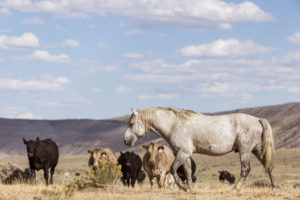
Federal Magistrate Judge Mikel Williams Grants Western Watersheds Project’s Motion For Summary Judgment And Overturns the U.S. Fish and Wildlife Service’s Decision Not To Protect Slickspot Peppergrass Under the Endangered Species Act.
May 6, 2008
Contacts:
Todd Tucci :208-724-2142
Katie Fite: 208-429-1679
Western Watersheds Project has won another round of federal court litigation over protection of the Slickspot peppergrass (Lepidium papilliferum).
Slickspot peppergrass is a rare annual or biennial Idaho endemic flower that grows in the sagebrush country of the Snake River Plain and portions of Owyhee County in the Jarbidge region.
Direct threats to slickspot peppergrass are cheatgrass invasion and fire. Cattle trampling and other disturbance to the fragile smooth desert “slickspot†soils in the sagebrush areas where this plant grows promote cheatgrass and weed invasion. For a complete photo essay on Slickspot peppergrass please visit WWP’s Slickspot peppergrass web page:
Slickspot Peppergrass and Cows
On June 4, 2008 Federal District Court Magistrate Judge Judge Mikel H. Williams ruled that the U.S. Fish and Wildlife Service’s (FWS) Withdrawal of its own agency’s recommendations to list slickspot peppergrass as Threatened unlawful.
Judge Williams stated: “FWS scientists noted in great detail that the major threats to slickspot peppergrass (fire, invasive species, grazing, development) were not going to diminish in the future, and even with conservation plans, loss of habitat will occurâ€.
Todd Tucci, Senior Staff Attorney for Advocates for the West said:†FWS high-level Managers intervened to shunt science, reason and the public interest aside. They relied on trivia to undermine a decade of study, research and consensus of a broad body of scientists that shows slickspot peppergrass is heading to extinctionâ€.
To scuttle ESA listing for Slickspot peppergrass, the FWS managers scoured reports for what they termed “helpful uncertainties†to deny listing protection. For example, the agency seized on a consultant report that found more plants in years with rain – as if this was a startling revelation. At the same time, it ignored the same report’s grim summary of slickspot peppergrass status that recognized serious threats and population declines.
This is the latest ruling and victory for WWP in a long saga over Slickspot peppergrass over the past decade where Idaho politicians and the Bush administration repeatedly interfered with biological conclusions. In 2000, FWS had written a near-Final ESA Listing Rule because of its own scientists concerns about the downward trajectory of this plant in the sagebrush biome. Idaho’s senior politicians including Senator Mike Crapo, Senator Larry Craig and then Governor Dirk Kempthorne) stepped in to delay that early process, and the FWS effort stopped in 2001.
WWP wrote and submitted a petition to list this species in 2001. Judge William’s June 2008 Decision is the fourth time since WWP filed that petition since the arbitrary actions and of the Bush FWS have been found to violate the law.
This latest court-ordered listing review process began in 2006. It started off with a meeting between the FWS Director and Idaho politicians Larry Craig, Mike Crapo, and then-Congressman (now Governor) C.L. “Butch†Otter.
“Such meddling will only make survival of this plant more costly and difficult in the end†observed WWP Biodiversity Director Katie Fite. “The longer grazing destruction of its sagebrush habitat continues – the more difficult recovery becomes. Slickspot peppergrass is a bellwether of the health of the sagebrush ecosystem in southern Idaho. What’s going on here is that the ranchers don’t like what the science shows about the fragility of the sagebrush system. Livestock trampling buries the peppergrass seeds too deep in the soil to be able to grow, and it fosters weeds as the living microbiotic crust soil covering is punctured by thousand pound cattle.
Sadly, it seems this small group of subsidized public lands ranchers, and the politicians that obsess over shielding them from accountability, would rather see the entire sagebrush region of southern Idaho become converted to a permanent sea of cheatgrass where Slickspot peppergrass, sage grouse, pygmy rabbit and all its other tremendous biological riches will be lost to society foreverâ€.
Western Watersheds Project Is A Regional Conservation Organization
Working To Protect And Restore Western Watersheds And Wildlife
https://westernwatersheds.org
Consider joining Western Watersheds Project yourself or enrolling a friend with a gift membership. Joining is easy at WWP’s secure online membership page.






